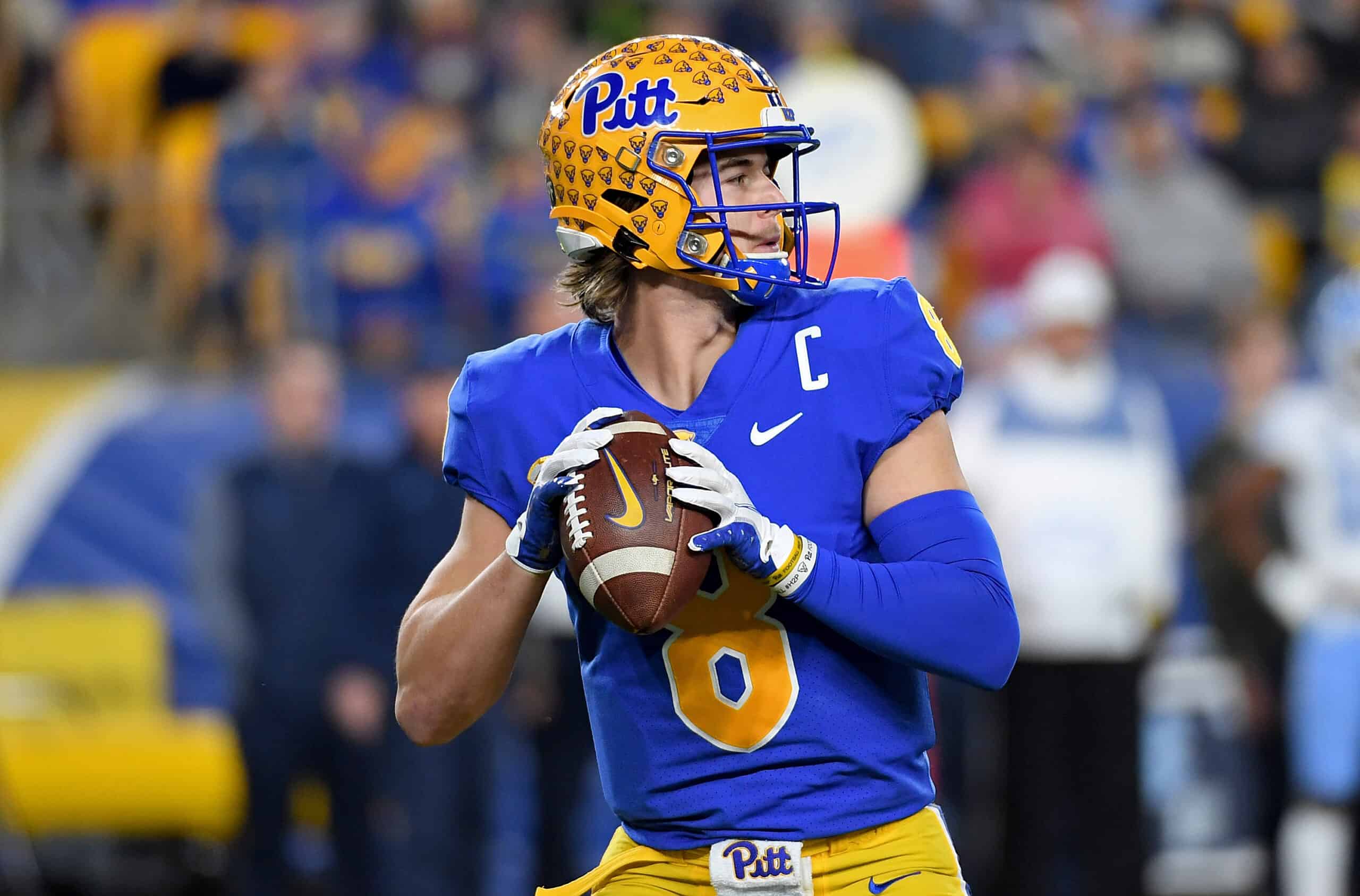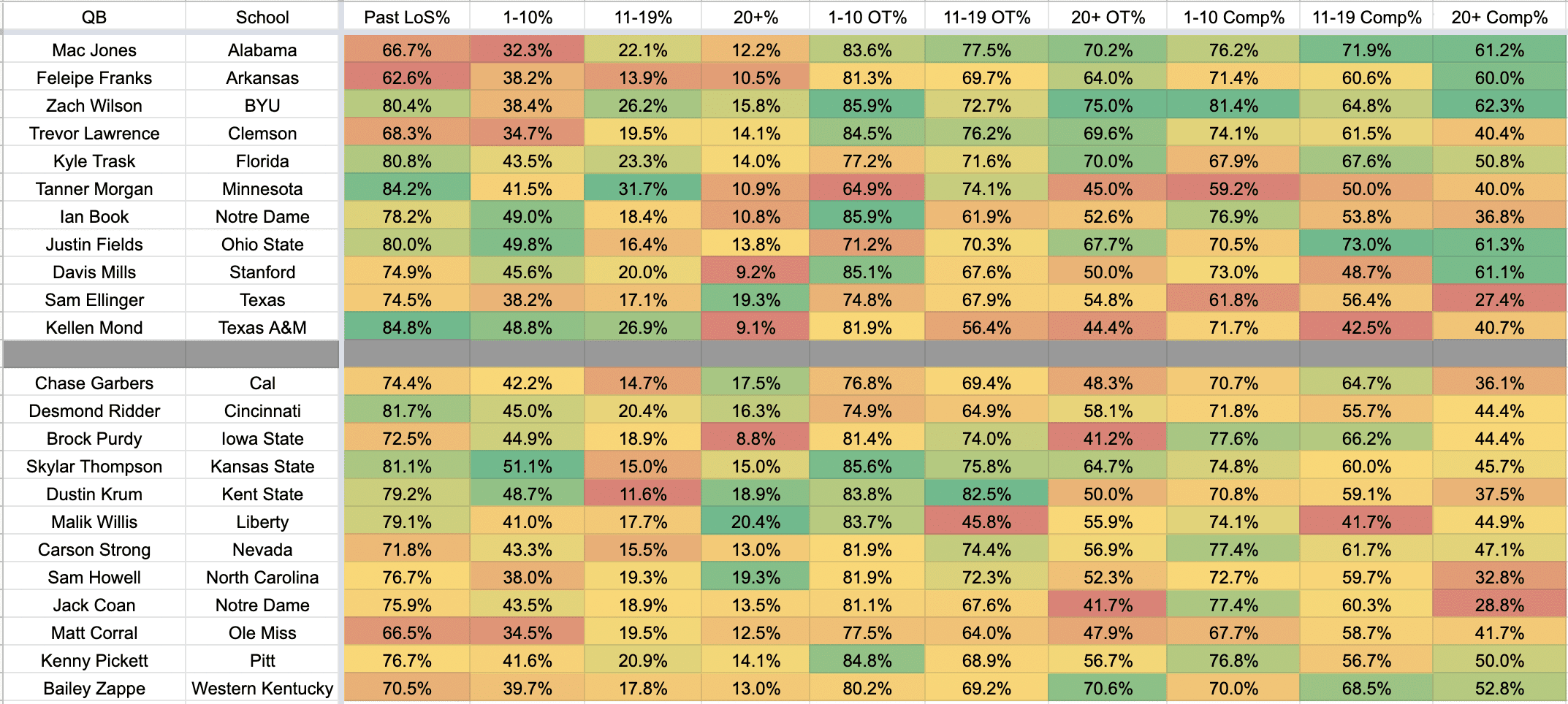Getting the ball where it needs to be is a fairly big part of the job description for a successful NFL quarterback. But over the past few years, the idea of accuracy has been placed on a sliding scale depending on the quarterback’s style of play.
Joe Burrow was the league’s most accurate quarterback in the league during the 2021 season, per Sports Info Solutions’s on-target rate. Burrow thrives on pinpoint accuracy and master processing both before and after the snap.
But not all quarterbacks need to win in that way. Among 42 quarterbacks who threw at least 100 passes in 2021, Patrick Mahomes ranked 18th in overall on-target rate. Josh Allen ranked 21st. Tom Brady ranked 25th. Matthew Stafford ranked 27th.
On the other side of things, Jared Goff ranked ninth, Tua Tagovailoa ranked eighth, and Trevor Siemian ranked 11th.
Accuracy is a needed skill but it only does so much if other high-level skills are not also included. The ability to create explosive throws also decreased the need to rely on play-to-play accuracy.
All of that brings us to the quarterback class in the 2022 NFL Draft, which frankly, lacks a bit on both sides of that spectrum.
The chart below shows us quarterbacks in this draft class, how often they’ve thrown to each level of the field (short passes of 1-10 air yards, intermediate passes of 11-19 air yards, and deep passes of 20+ air yards), their on-target rates to each level, and their completion percentages.
2022 Draft Class Quarterbacks, Throw Rates, On-Target%, and Completion%
data provided by Sports Info Solutions
What stands out at first is that no quarterback truly stands out. Not only are these numbers generally low overall, no one prospect stands above the rest. That plays both into the idea that this class isn’t the strongest and there is no consensus No. 1 passer of the group.
Compare this year’s class to last year’s filled with some overall accurate quarterbacks and one of the best groups of deep passers we’ve seen.
2021 vs 2022 Quarterback Draft Class
There’s a lot to take in on those charts — and admittedly they’re not the most visually friendly — so let’s get into some things we can take away from them.
Killing The Short Game
One area where we do see some prospects from the 2022 class stand out comes on short passes between 1-10 air yards. For the purpose of this exercise, we’ll focus on Kenny Pickett and Malik Willis, both considered to be at the top of this year’s class.
Neither quarterback overly relied on those short passes, but they were among the most accurate to that part of the field. That checks out for Pickett, though some might be surprised by Willis’s success in that area, a piece of his game that has not been brought up often.
Accuracy here is important because even as we enter a time when offenses are searching for the explosive play, nearly half of the passes in the NFL traveled between 1-10 air yards last season. However, there is a little disconnect between how often those passes are thrown and how valuable they are.
Among 31 quarterbacks who were passer rating qualified in the NFL last season, the average EPA per dropback of throws between 1-10 air yards was 0.11, compared to 0.36 for intermediate passes and 0.40 for deep passes, per TruMedia.
There was even the slightest difference in frequency of these throws between successful and non-successful quarterbacks. Last season among that group of quarterbacks, those that finished with negative EPA per dropback threw 22.1% of their passes behind the line of scrimmage, 49.9% short, 16.5% intermediate, and 11.4% deep on average. Quarterbacks who finished with above-average EPA threw 21.8% of passes behind the line, 48.8% short, 17.1% intermediate, and 12.4% deep.
Having that short accuracy is a good starting point, but it’s just that. Successful quarterbacks will build off of that, while others have to rely on it.
An interesting comp here for Pickett might be Davis Mills, a 2021 third-round pick, who started 11 games for the Houston Texans and is likely to get another go at it in 2022. Mills had similar accuracy numbers to Pickett as a prospect, though the rate of where those throws went and how often they were completed differed.
When Mills became the Texans’ starter, there was a built-in skill the team could scheme around. 51.3% of Mills’s passes traveled between 1-10 yards past the line of scrimmage. Mills, though, averaged just -0.11 EPA per dropback overall.
Those short passes can also increase for players who might not have the arm or offense to take advantage of deeper passes. In his final year at Alabama, Mac Jones only threw 32.3% of his passes between 1-10 air yards (though he heavily threw behind the line of scrimmage) but during his rookie season, 51.4% of his passes were short.
On the other side of the short success falls Desmond Ridder. Ridder is widely viewed as one of the best processors in this class, if not the best. But quick and short passes were not his forte in 2021. Not only did Ridder the only quarterback in the class with an on-target rate from 1-10 air yards below 75%, but he also has the lowest on-target rate on 0/1-step drops at just 72.4%.
Kenny Pickett’s Deep Splits
The best quarterbacks are hitting those deeper passes and that’s where some questions arise, especially for Pickett and Willis. Pickett’s arm and processing put him closer to the need for top accuracy on intermediate and deep throws, but that hasn’t really been the case for him in his college career.
His deep success (and likely in other areas too) was largely tied to Jordan Addison, a true sophomore wide receiver, who won the Biletnikoff Award as college football’s most outstanding receiver in 2021. Addison pops all over Pickett’s film by either running wide-open or making plays out of nothing, and that’s especially true on deep passes. Per SIS, Addison accounted for 51.4% of Pitt’s deep targets, 56.5% of Pitt’s catchable deep targets, 55.3% of Pitt’s deep receptions, and 58.4% of Pitt’s deep receiving yards.
On deep throws to not Jordan Addison, the on-target rate was just 47.2%.
These little discrepancies also are highlighted in Pickett's overall performance. His 88% catchable rate was the highest among these quarterbacks in the draft class, though his 78% on-target rate was fourth. Especially when so much of that accuracy falls in the short game, those differences between catchable and truly on-target become magnified in the NFL.
Malik Willis’s Intermediate Struggles
We touched on this when we wrote about Willis individually, but his 45.1% on-target rate on intermediate passes is not just the lowest among draft prospects, but also in college football as a whole. But at the same time, Willis was more than fine on those throws in 2020 when his on-target rate was 75%, which would have been among the best over the past two draft classes.
Part of that came from how often Willis threw outside the numbers on throws of that depth. 51.7% of Willis’s intermediate passes went outside in 2021 with just a 43.3% on-target rate and 1.4 Adjusted Net Yards per Attempt (ANY/A). All of those marks were down significantly from 2020 when Willis threw just 39.2% of his intermediate attempts to the outside with a 70% on-target rate and 9.3 ANY/A.
Willis also falls into a category of a player who will likely be reigned in a bit more at the next level. Willis’s 17.7% intermediate rate is strong and would be above average among NFL quarterbacks from last season. While his 20.4% deep passing rate is impressive, it’s nowhere near a rate at which he can live in the pros. Last season, Russell Wilson had the highest rate of deep throws at 18.5%. Justin Fields, who might be a Willis rookie year comp, was second at 15.6%, per TruMedia.
While Willis’s arm strength is a big selling point, having fewer deep throws could be seen as a benefit to his game by allowing him to pick spots better for more effective throws while replacing those extra deep attempts with more completable short passes. That is an under-discussed college-to-pro transition that could help quarterbacks such as Willis.
Figuring Out Matt Corral
At Ole Miss, Matt Corral ran an RPO-heavy offense and so much of the success there came with what he did behind the line of scrimmage. Corral easily had the lowest rate of passes beyond the line of scrimmage (just 66.5%). On top of that, Corral wasn’t particularly impressive in accuracy when he did throw past the line.
One would think an RPO offense would open up some throws in the short game but Corral was poor in both on-target rate and completion percentage on throws of 1-10 air yards while only 34.5% of his passes were to that depth.
He also didn’t make a mark on deep passes, where his 47.9% on-target rate topped only Jack Coan and Brock Purdy’s 2021 figures in this class.
Where Desmond Ridder Wins
Ridder's short-area inaccuracy certainly raises some questions, but no quarterback in this class was asked to throw past the line of scrimmage more than Ridder (81.7% of attempts). And while those short passes weren't always effective, Ridder did have a good deep ball with a 58.1% on-target rate.
With so much asked of him beyond the line, Ridder was a fast processer who routinely got the ball where it should go — even if the accuracy wasn't always there. Per SIS, Ridder had a faster than expected time from snap to throw and from throw to arrival, meaning Ridder gets the ball out quickly and it gets to the receiver just as fast.
We often see young quarterbacks be late in processing and those with the superior arm strength can make up for it by rocketing the ball in. Ridder, to this point, has been the opposite. He's processing quickly and getting the ball to its spot early, which has its own built-in margin for error.
There might be a slightly higher degree of difficulty translating that early processing into a workable skill level in the NFL, but that's where Ridder could find an avenue to make up for an overall accuracy level that could cause some other problems as he develops.



















